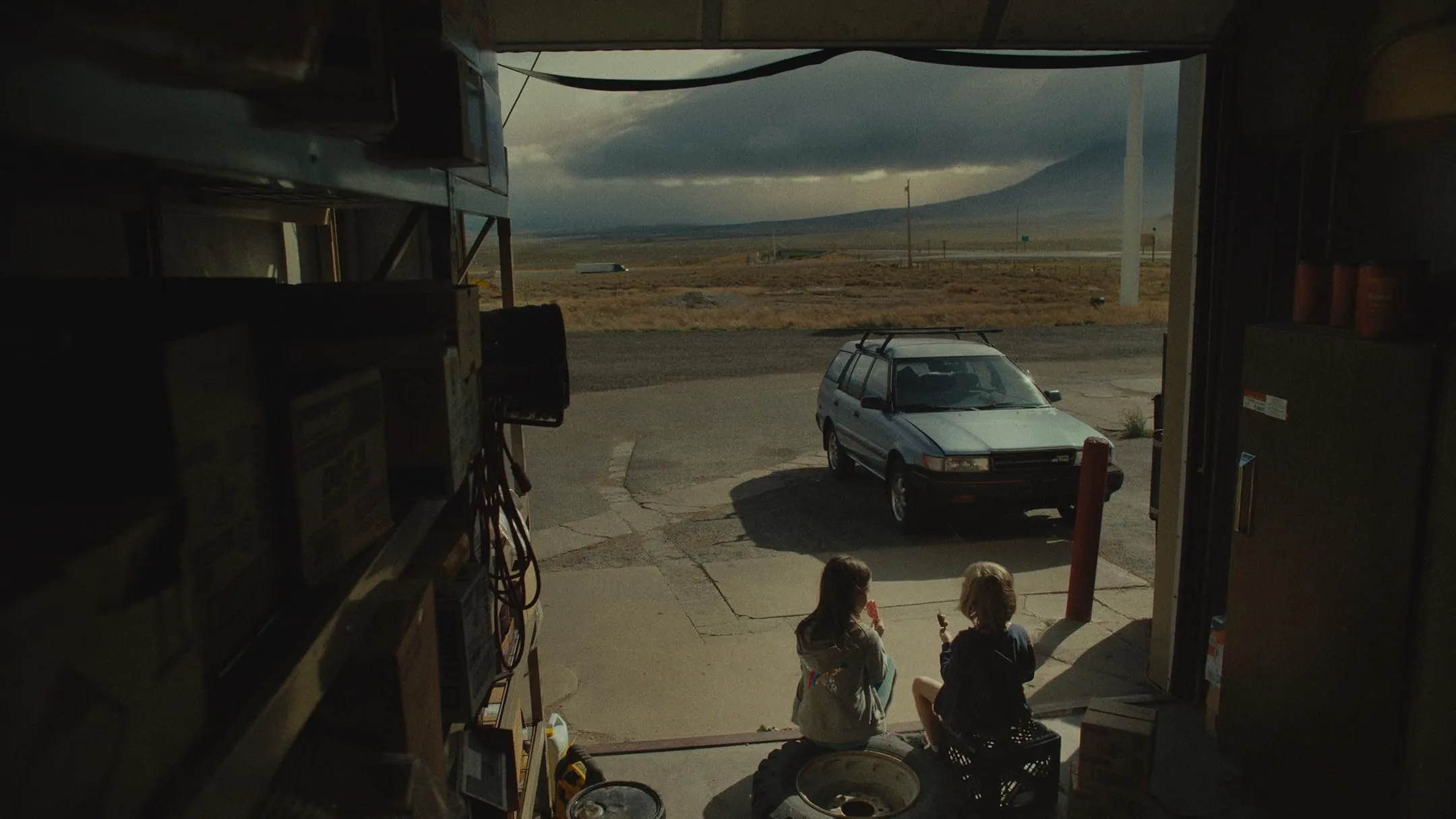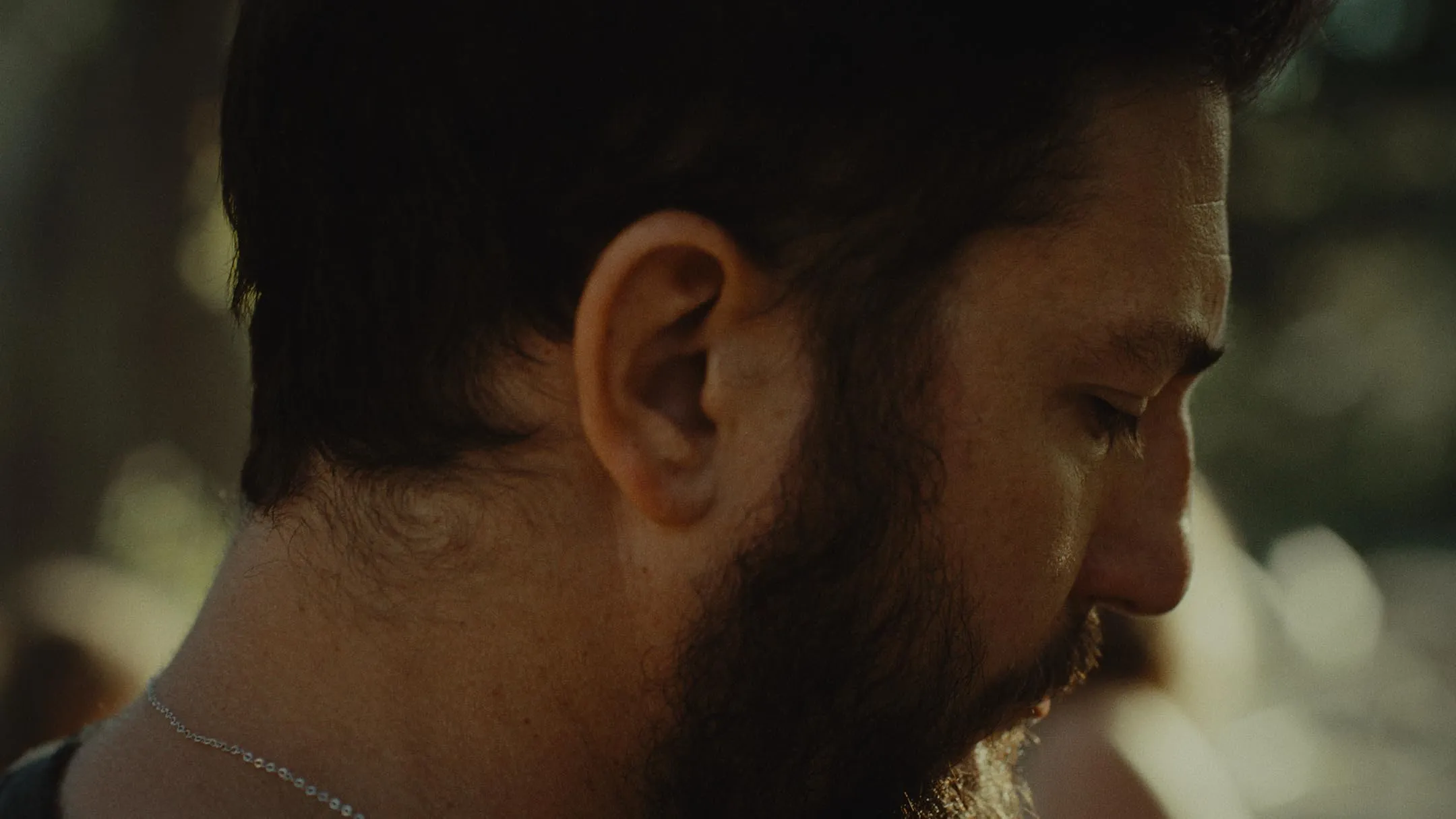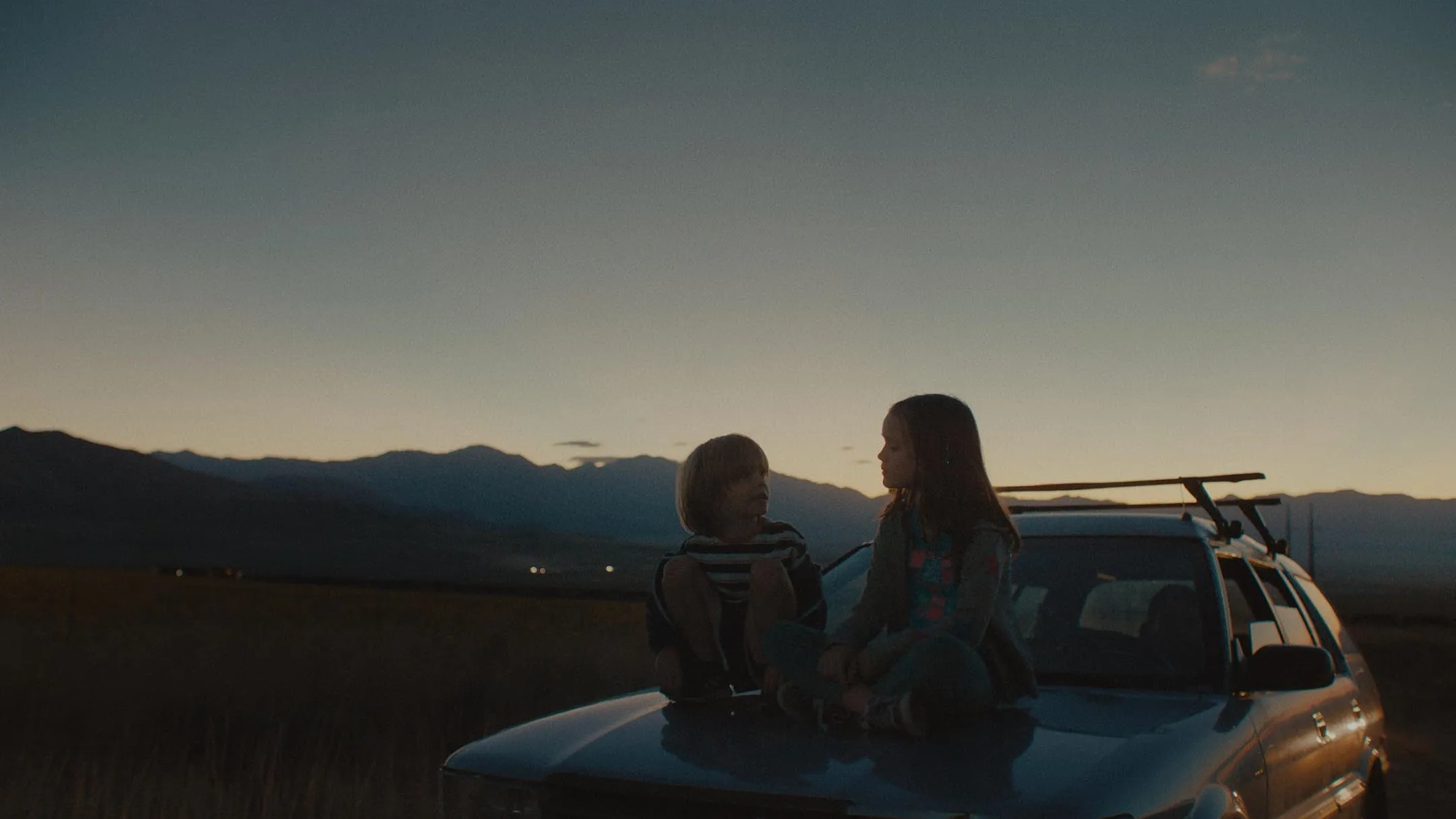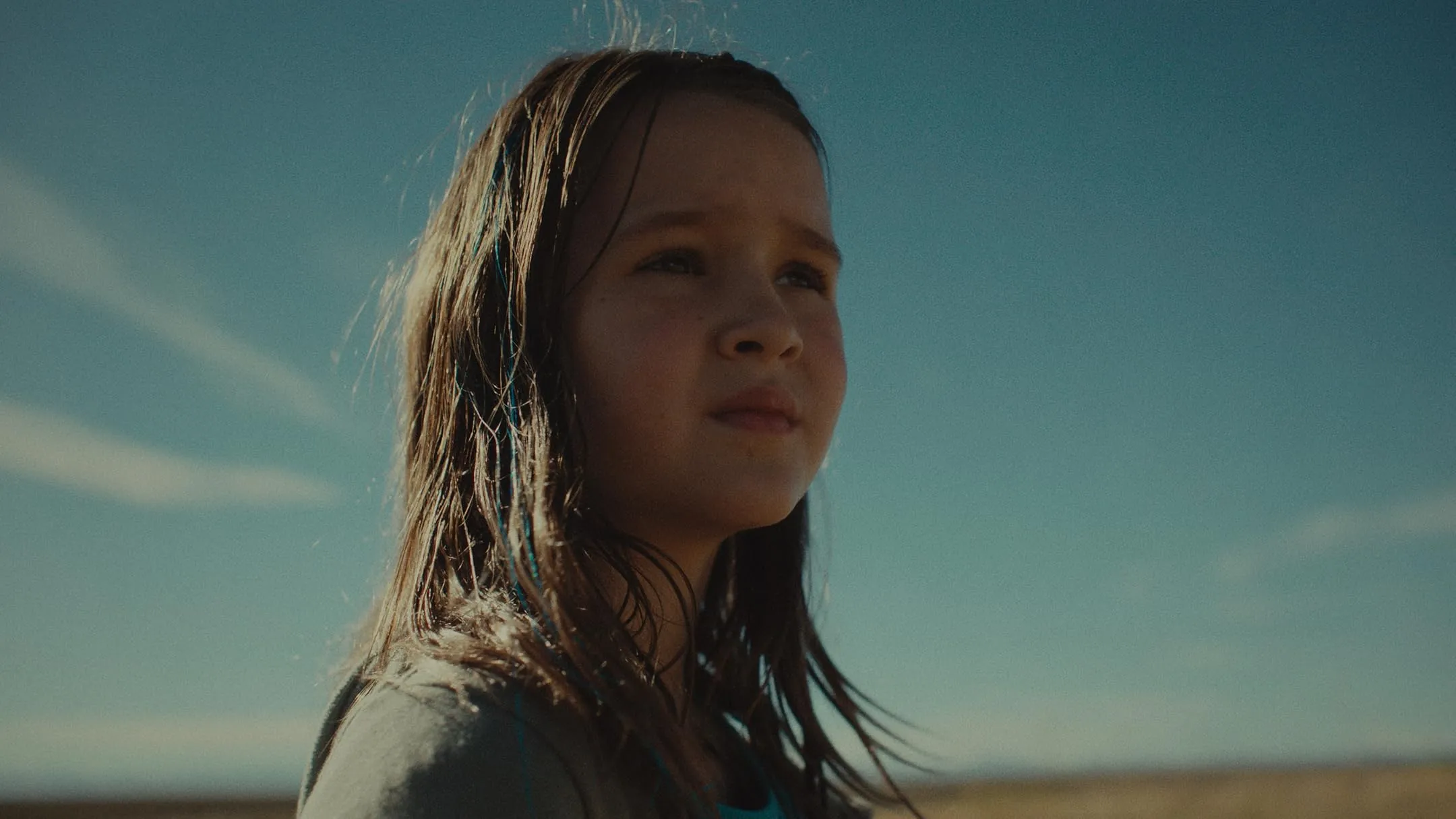Cole Webley’s film opens with a quiet tension that feels deeply personal. A widowed father, portrayed by John Magaro with subtle pain, wakes his two young children and guides them into an old car, their uncertain path heavy with unspoken struggle. Against the stark backdrop of the 2008 economic crisis, the story tracks their movement from a seized home in the Southwest to Omaha, Nebraska—a destination as mysterious as the father’s silent motivations.
On the surface, this appears like a simple road trip—filled with cheap gas station trinkets, quick meals, and brief sparks of childhood happiness. Beneath this exterior lies a stark exploration of family fragility, grief’s deep weight, and the disintegrating myth of shared national hope.
The film premiered at Sundance, quietly capturing audience attention through its restrained storytelling. Webley’s direction feels both unflinching and compassionate, capturing the stark, empty American terrain while keeping focus on the quiet human struggle inside a worn vehicle. Its rhythm moves slowly, each scene feeling like a quiet meditation on loss and survival.
Webley crafts a cinematic experience that feels raw and unvarnished—an authentic slice of storytelling that sits with its characters in unbroken silence. The film asks viewers to watch closely, offering emotional moments that echo well past its final scene.
The Weight of Silence: A Family in Fragments
John Magaro embodies the father in Omaha with raw emotional depth, painting a portrait of a man drowning in economic struggle and personal grief. His performance reveals a complex character—silent yet expressive, fragile yet protective.
Magaro portrays a father trying to shield his children from their harsh reality, his facial expressions communicating deep internal pain without words. Whether standing quietly at a gas station or wrestling with financial constraints, he reveals a man fighting to maintain dignity amid overwhelming challenges.
Molly Belle Wright delivers a striking portrayal of Ella, a nine-year-old who carries adult responsibilities. Her performance captures the nuanced experience of a child navigating complex family dynamics. Wright communicates Ella’s internal conflict through subtle gestures, revealing a character who understands more than her years suggest. Her scenes with Magaro crackle with unspoken emotional undertones, showing a sibling relationship built on mutual protection and understanding.
Wyatt Solis brings lightness to the narrative as Charlie, a child whose innocence provides contrast to the family’s struggles. His performance feels genuine and unforced, capturing the carefree spirit of childhood while subtly hinting at underlying vulnerabilities. Solis creates a character who feels real and unaffected, moving between playful moments and instances of quiet awareness.
Fractured Dreams: Grief, Hardship, and the Glimmer of Hope
Omaha delves into the quiet sorrow of loss, presenting grief with raw honesty. The mother’s death permeates every scene—her absence visible in unfinished laundry, wilting flowers, and the father’s hushed prayers to a vanished companion.
Each frame captures the aftermath of her passing: a father’s silent anguish, Ella’s premature wisdom, and Charlie’s innocent dependence on his sister. A piercing moment emerges when the family listens to a recording of the mother’s voice, her laughter echoing like a fragile memory.
Economic struggle shadows the narrative, manifesting through boarded homes, foreclosure notices, and the father’s empty wallet. Each visual element reveals a family wrestling with financial collapse. A poignant scene shows the father pausing at a gas station, unable to purchase two kites for his children—a small gesture that exposes their precarious existence.
Amid bleakness, Ella and Charlie discover fleeting moments of happiness. They find pleasure in simple experiences—soaring kites across salt flats, bouncing on motel beds, singing along to a cassette tape. These instances of childhood wonder emerge as quiet rebellions against surrounding hardship, revealing the resilient spirit that persists through challenging circumstances.
A Landscape of Loss and Longing: The Visual Poetry of Omaha
Paul Meyers crafts Omaha through a visual approach that reveals the stark landscape of the American West—its expansive skies and profound solitude. The film’s visual strategy alternates between close personal shots and wide landscape views, revealing the tension between family dynamics and the surrounding environment.
During a memorable scene, the family flies kites on the Bonneville Salt Flats, white terrain stretching beyond sight while children’s laughter cuts through surrounding quiet. This moment of brief happiness gains depth through underlying narrative tension. The car becomes a contained world, with camera shots focusing on the father’s grip on the steering wheel or Ella’s tense glances, each frame communicating unspoken emotional weight.
Light and color operate with careful intention, their nuanced changes tracking the story’s emotional geography. Pale, faded dawn tones when the family leaves home suggest displacement and loss, while golden sunset light during a motel stay provides temporary solace.
A scene featuring a fireworks display illuminates their faces with alternating wonder and melancholy, creating a visual metaphor of simultaneous beauty and sorrow. Meyers’ visual storytelling transforms ordinary moments into extraordinary statements about human experience.
The Art of Restraint: Webley and Machoian’s Collaborative Vision
Cole Webley crafts a subtle cinematic experience in Omaha, revealing exceptional skill with character and narrative. Webley avoids melodrama, letting emotional undertones surface through quiet moments. His technique navigates between tender scenes of poolside play and profound scenes of paternal contemplation, creating a nuanced emotional landscape.
Webley’s storytelling moves with deliberate restraint, inviting viewers into intimate spaces with characters wrestling with grief and uncertainty. His approach prioritizes small, meaningful gestures: Ella’s gentle touch on her father’s shoulder, Charlie’s unexpected laughter piercing heavy silence. This film speaks through subtle interactions, trusting audiences to interpret emotional depths.
Robert Machoian’s screenplay provides the narrative skeleton, grounding the story in raw realism. The script operates with economic precision, revealing the family’s struggles through carefully placed details—a foreclosure notice, diminishing cash reserves, a homemade CD with a mother’s recorded voice. Machoian constructs character arcs through minimal dialogue, allowing unspoken emotions significant weight.
Each scene explores familial dynamics with surgical precision: Ella’s mature attempts to comprehend her father’s struggles, Charlie’s innocent disconnection from their challenging circumstances. The screenplay transforms silence into a profound communication method, expressing complex emotional states through understated interactions.
A Lingering Echo: The Enduring Power of Omaha
Omaha is a film that lingers, its emotional weight resonating beyond the screen. By intertwining personal stories with broader social themes, it explores loss and human resilience. The film captures the struggle with economic challenges and family connections, reflecting current societal tensions. Despite its somber mood, the film reveals moments of hope and connection.
The film’s impact stems from nuanced performances, visual storytelling, and careful emotional balance. Its measured pace invites viewers to engage deeply with the narrative. Audiences who embrace its subtle approach will discover a profound cinematic experience that explores human vulnerability and strength.
The Review
Omaha
Cole Webley's debut film delves into themes of loss, inner strength, and American social tensions. The movie captures raw emotional landscapes through restrained visual storytelling and subtle acting performances. Quiet moments reveal deep psychological terrain without heavy-handed exposition. Viewers seeking nuanced character studies will appreciate the film's measured approach to dramatic narrative. The work captures personal struggles against a backdrop of unspoken societal pressures, presenting a stark exploration of individual experiences within broader cultural contexts.
PROS
- Powerful, understated performances, particularly from John Magaro and Molly Belle Wright.
- Evocative cinematography that captures both intimate moments and vast landscapes.
- A deeply emotional and resonant exploration of grief, family, and economic hardship.
- A balanced tone that weaves moments of joy and hope into a somber narrative.
CONS
- Deliberate pacing may feel slow for some viewers.
- The final act’s revelations, while impactful, could feel rushed to some.
- Minimal dialogue and subtle storytelling may not appeal to those seeking a more overt narrative.




















































